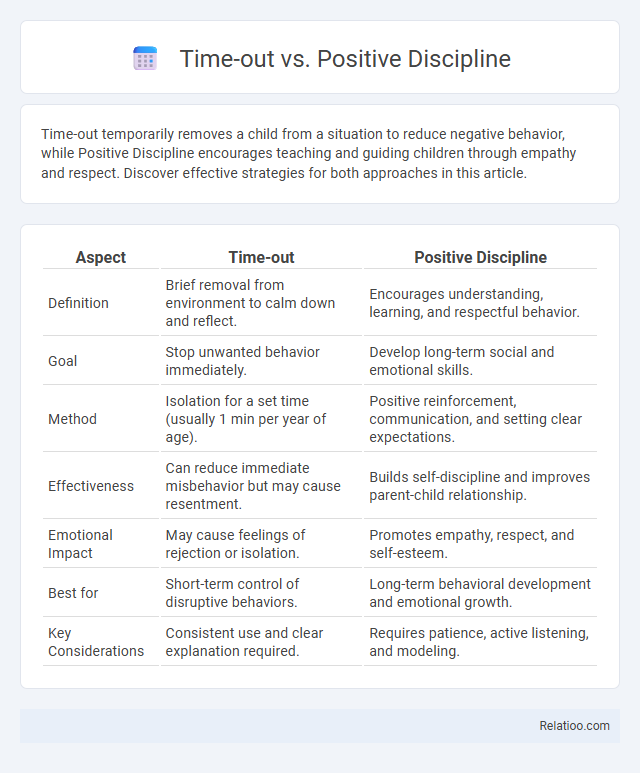Time-out temporarily removes a child from a situation to reduce negative behavior, while Positive Discipline encourages teaching and guiding children through empathy and respect. Discover effective strategies for both approaches in this article.
Table of Comparison
| Aspect | Time-out | Positive Discipline |
|---|---|---|
| Definition | Brief removal from environment to calm down and reflect. | Encourages understanding, learning, and respectful behavior. |
| Goal | Stop unwanted behavior immediately. | Develop long-term social and emotional skills. |
| Method | Isolation for a set time (usually 1 min per year of age). | Positive reinforcement, communication, and setting clear expectations. |
| Effectiveness | Can reduce immediate misbehavior but may cause resentment. | Builds self-discipline and improves parent-child relationship. |
| Emotional Impact | May cause feelings of rejection or isolation. | Promotes empathy, respect, and self-esteem. |
| Best for | Short-term control of disruptive behaviors. | Long-term behavioral development and emotional growth. |
| Key Considerations | Consistent use and clear explanation required. | Requires patience, active listening, and modeling. |
Understanding Time-out: Definition and Purpose
Time-out is a behavioral strategy designed to remove a child from an environment where inappropriate behavior occurs, providing a brief period for reflection and self-regulation. Unlike positive discipline, which emphasizes teaching and reinforcing desirable behaviors through encouragement and natural consequences, time-out serves as a clear, immediate response to misbehavior to reduce undesirable actions. Understanding time-out helps Your approach to discipline by clarifying its role as a tool for managing behavior rather than a punishment, promoting emotional control and accountability.
What is Positive Discipline? Core Principles
Positive Discipline is a child-rearing approach emphasizing respect, encouragement, and mutual problem-solving to foster long-term emotional growth and responsibility. Core principles include mutual respect, effective communication, understanding the reasons behind behavior, and teaching children to develop self-discipline and accountability. Your role involves guiding rather than punishing, helping your child learn from mistakes while maintaining a supportive environment.
Key Differences Between Time-out and Positive Discipline
Time-out involves temporarily removing a child from a situation to decrease unwanted behavior, emphasizing consequences and compliance. Positive Discipline focuses on teaching and guiding children through encouragement, problem-solving, and understanding emotions to promote long-term behavioral growth. The key difference is that Time-out is a reactive strategy aimed at immediate behavior correction, while Positive Discipline is proactive, fostering skills and self-regulation for lasting development.
Pros and Cons of Using Time-out
Time-out can effectively reduce undesirable behavior by providing children a clear consequence and a chance to calm down, promoting self-regulation skills. However, overuse or misuse of time-out may lead to feelings of isolation or resentment, negatively impacting a child's emotional development and your relationship with them. Positive Discipline focuses on teaching and guiding behavior through encouragement and problem-solving, offering long-term benefits in self-esteem and cooperation but may require more patience and consistency from caregivers.
Benefits of Adopting Positive Discipline
Positive Discipline fosters long-term emotional growth by encouraging empathy, self-regulation, and responsible behavior, unlike Time-out, which primarily serves as a short-term behavior correction method. This approach cultivates stronger parent-child relationships through respectful communication and problem-solving skills, resulting in improved social competence and reduced behavioral issues. Embracing Positive Discipline supports children's intrinsic motivation and self-esteem, promoting sustainable positive behavior changes.
Common Misconceptions About Time-out
Time-out is often misunderstood as a form of punishment rather than a chance for children to calm down and reflect, which contrasts with positive discipline that emphasizes teaching and reinforcing good behavior. Unlike time-out, positive discipline focuses on communication, mutual respect, and problem-solving skills to guide behavior without creating fear or resentment. You can better support your child's emotional development by understanding that time-out is a temporary strategy for behavioral management, not a negative label or consequence.
Effective Strategies for Implementing Positive Discipline
Effective strategies for implementing positive discipline emphasize clear communication, consistent expectations, and reinforcement of desired behaviors, fostering intrinsic motivation in children. Unlike traditional time-out methods, which isolate a child as a form of punishment, positive discipline encourages problem-solving and emotional regulation through empathy and guidance. Your approach can be enhanced by integrating time-out selectively, ensuring it serves as a calm-down opportunity rather than a punitive measure.
Age-Appropriate Approaches: Time-out vs Positive Discipline
Time-out works best for toddlers aged 2 to 5 by providing a brief break to calm down, while positive discipline suits preschoolers and older children by encouraging problem-solving and emotional regulation. Your choice should consider developmental stages: younger children benefit from simple, consistent time-outs, whereas older kids respond better to discussions about behavior consequences and empathy building. Tailoring discipline to your child's age improves effectiveness and fosters long-term emotional growth.
Cultural Perspectives on Discipline Methods
Time-out, Positive Discipline, and other discipline methods vary significantly across cultures, reflecting diverse values and child-rearing philosophies. In many Western societies, Positive Discipline emphasizes mutual respect and emotional understanding, while time-out may be viewed as a neutral consequence. Your choice of discipline should consider cultural context, as some cultures prioritize collective harmony or strict authority, influencing how children respond to these methods.
Choosing the Best Approach for Your Child
Choosing the best approach for your child involves understanding the distinct benefits of time-out, positive discipline, and a combined strategy. Time-out helps in calming your child and reducing immediate misbehavior, while positive discipline promotes long-term emotional growth and responsibility by emphasizing communication and empathy. You can enhance your child's development by tailoring methods that balance clear boundaries with supportive guidance.

Infographic: Time-out vs Positive Discipline
 relatioo.com
relatioo.com